I grew up skiing on the East Coast. I learned how on a small hill called Powder Ridge Mountain Park and Resort in Middlefield, Connecticut. College brought me farther north, first to the University of Maine at Farmington for its two-year ski-industry program and then to the University of Vermont, where I coached the Sugarbush freeride team for a few seasons. The group of friends I skied with then went on to start Ski the East, an apparel and film company launched in 2005 to show the world that skiing in the East isn’t just ice—powder and backcountry options are abundant if you’re willing to look for them.
While there’s some good skiing just southeast, at resorts like West Virginia’s Snowshoe Mountain, I rarely felt the need to leave New England. I fell in love with the woods surrounding Mount Mansfield, at Stowe Mountain Resort in Vermont, and spent the next decade living in the state and exploring every corner of it. From 2,000 feet of vertical at Mad River Glen to the local runs at Stowe, here’s proof that skiing the “ice coast” is more than you give it credit for.
Mad River Glen, Vermont
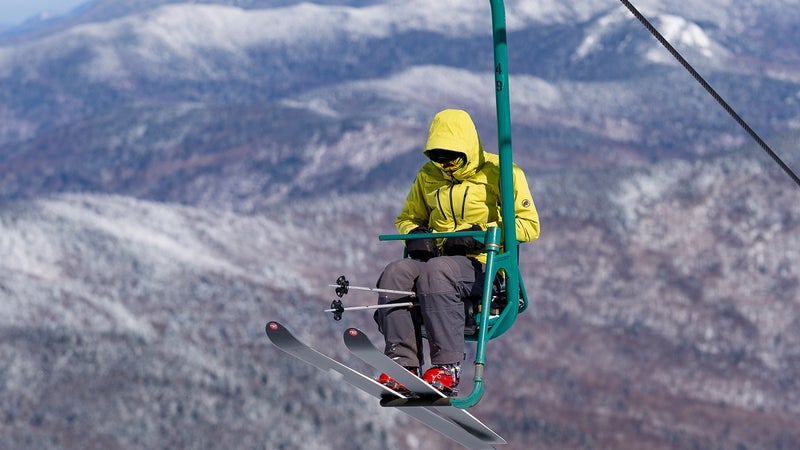
The slow churn of that iconic single chair—one of two left in the country—chugging uphill to the summit of General Stark Mountain and Mad River Glen (full-day tickets from $92), provides solitude in a ski area that’s stuck in a time capsule. Mad River is the antithesis of modern-day skiing, and therein lies its appeal. Even with the addition of three double chairlifts over the years, the resort has managed to preserve the snow experience on the hill.
I still recall sitting on the lone seater one March morning over a decade ago, snow pelting down on me, when I heard the words “Holy shit!” from one of my buddies two chairs ahead, as he came into view of how much snow had actually come down the previous night. An overnight storm had called for ten inches but delivered much more, easily two feet of fresh snow. It was the beginning of a special day. We glided off the chair, sidestepped up to Paradise run and its adjoining glades, and arced through the trees in absurdly deep and light powder.
The winding trails that contour Mad River and its never-ending tree-skiing terrain are a magical experience. The area has the reputation of needing to bring your A game. The runs are narrow and steep. Mad River provides as close to a backcountry experience in a ski area as you’ll ever get.
Need to Know
Timing is your best bet to score at Mad River Glen. Since the area lacks snowmaking, wait until a couple of storms hit and have provided a base. When the midwinter gales blanket Vermont, the mountain comes alive.
Don’t miss the classic gladed run called Paradise off the single chair. Especially if it’s a powder day. There are other tree stashes in and around this area; however, be warned that some have sizable cliffs if you venture past the designated runs. Additionally, Fall Line and Chute are legendary runs when the snow is soft. On the other side of the mountain, the double chairs lead to more manageable glades and trails for less advanced skiers. At the end of the day, a final burner down the twists and turns of Upper and Lower Antelope is a fun tradition. Follow that with a Vermont microbrew at General Stark’s Pub, located in the resort’s base lodge.
Appreciate the history. Mad River Glen was founded in 1948 by Roland Palmedo, a legend among early ski pioneers. He envisioned “a ski area [that’s] not just a place of business, a mountain amusement park, as it were. Instead, it is a winter community whose members, both skiers and area personnel, are dedicated to the enjoyment of the sport.” That mission still rings true, as the ski industry faces pressures of resort consolidation, with many areas turning into mock Disneylands. Today, Mad River continues to operate as a co-op that was set up in 1995.
Drop your snowboarding friends off at nearby Sugarbush Ski Resort. Mad River Glen doesn’t allow snowboarding. It has nothing to do with animosity; it’s a policy based on the mountain’s terrain.
When to Go
January through March is prime time at Mad River. Sometimes December is snowy, but winter storms can be fickle in Vermont during the early season. Keep your eye on the weather if you’re flexible, but generally, the midwinter months will provide great conditions. Expect crowds during holiday breaks.
How to Get There
Fly into Burlington, Vermont. It’s about an hour drive from there to Mad River. Rent a car that can handle winter conditions. Or drive up from Boston (a four-hour trip) or New York City (a 5.5-hour trip).
The Intel
Where to Stay
You’ll have your choice of historic Vermont B&Bs and private ski chalets a short drive from the resort. The eight-room Yellow Farmhouse Inn (from $149), in the town of Waitsfield, is just 15 minutes away, and a quarter mile north of the resort is this four-bedroom private home (from $250), perfect for groups or families.
Terrain
If you want to ski New England glades in soft snow, Mad River is your place—the area has a well-run glading crew in the summer and autumn months. If you’re looking for backcountry zones, stashes are kept on the hush, so prepare to befriend a local in hopes of them divulging beta. The mountain has 2,037 feet of vertical, with 45 percent of the area labeled expert terrain, 35 percent intermediate, and 20 percent novice. The resort grooms some novice and intermediate trails when conditions permit.
Off Hill
Visit Lawson’s Finest Liquids. The former head of Mad River Glen’s naturalist programs brews some of the finest beer in the state and recently opened a new tap house. Don’t miss American Flatbread in Waitsfield for wood-fired pizzas.
The Bottom Line
Mad River is great for skiers looking to charge hard, but it’s equally good for families with a variety of ability levels. It’s not for those who want a ski-resort experience but rather folks who want to ski without the noise and bustle.
Stowe Mountain Resort, Vermont
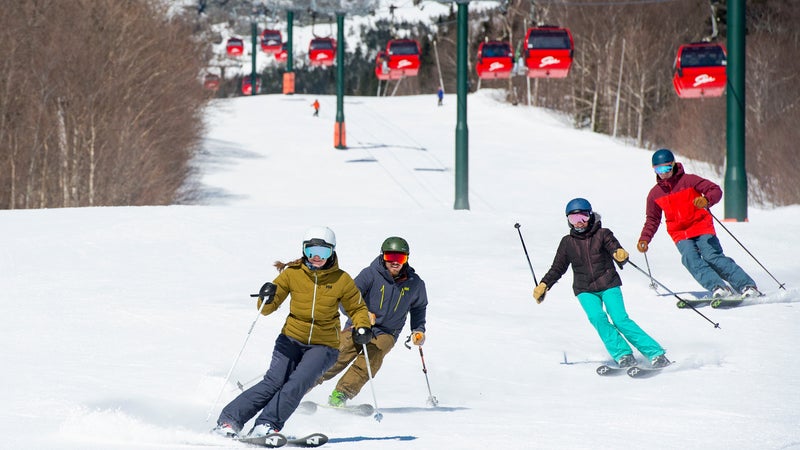
Stowe is considered the ski capital of the East. Even after Vail purchased the resort (day tickets from $78) in 2017, and it became part of the Epic Pass, and swanky hotels opened at the base of the area’s Spruce Peak, Stowe has remained an authentic ski town. The area is a product of legends from the early days of skiing, from the Mount Mansfield Ski Club, established in 1934, to trail crews from the Civilian Conservation Corps (CCC) that cut Bruce, Nosedive, and other storied runs. Stowe is hallowed ground for New England skiing.
Today it has been labeled the glitzy alternative to more humble places like Smugglers’ Notch (see below) or Mad River Glen. However, having spent a decade in the area, I know that it’s also home to one of the best ski-bum scenes in the region. I’m talking about skiers who work all summer so they can ski all winter, because they know all too well the snow bounty that Mount Mansfield receives and the nooks and crannies in the forest that hide it all.
Need to Know
Park on the Mansfield side. Stowe is divided into two zones: Spruce Peak and Mount Mansfield. The Spruce Peak side is where most of the ski-school and ski-club training happens. It’s also where the resort village and hotel are located. You’ll find more parking on the Mansfield side. Then simply jump on the Over Easy Gondola to get to the resort base.
Take advantage of the region’s best lift-served backcountry. The gondola gets you close to the 4,395-foot summit of Mount Mansfield. Once you’ve hiked to the top, there are numerous options to ski down, from long tours to shorter ones. Some runs return to the ski area, and others drop out on the other side of the mountain, into small towns. It’s easy to get lost if you don’t know where you’re going. Be prepared and treat Mansfield with respect and you’ll be rewarded with some of the best backcountry skiing east of the Mississippi. Well-known zones such as Angel Food or Hell Brook drop skiers onto Route 108, so expect a mile-and-a-half trek back to the resort if you can’t thumb a ride. If you’re venturing further into the nearby Smugglers’ Notch territory, bring avalanche gear, because slides do occur.
Start the day on the Fourrunner Quad. The main lift opens at 7:30 A.M. on weekends. If it’s a powder day, the Starr, Goat, Lookout, Liftline, and National runs are the places to be, but then head into the woods, either off the Quad or the gondola. Finish the day with a mellow schuss down Bruce Trail—an original CCC trail cut by Charlie Lord, the master designer of Stowe’s ski runs; it starts from the Octagon stop off the quad and terminates at the Matterhorn Bar and Grill, a popular local watering hole known for après and live music.
When to Go
Stowe fires up the snow guns at the first sign of continued cold, so go anytime between November and the end of April. It snows a lot here for the East—last year, Mount Mansfield’s base reached 120 inches at the height of the snowpack in March. Additionally, February seems to produce the best storms. And the holiday season is always busy, in addition to most weekends.
How to Get There
Fly into Burlington, and rent a car that can handle winter conditions. The resort is about an hour from that airport. Follow Interstate 89 to Exit 10, then take Route 100 into the town of Stowe, followed by a left at the stop sign onto Mountain Road.
The Intel
Where to Stay
There are a variety of slopeside and in-town options that range in price, from the fancy 300-room Lodge at Spruce Peak (from $204), just steps from the Over Easy Gondola, or the Town and Country hotel (from $100) in town, which has 43 recently renovated rooms and an in-house pizza joint. Or opt for condos or private homes offered by Stowe Vacation Rentals (from $169); many units are within walking distance of the Toll House Double lift.
Terrain
Stowe’s terrain is divided into 16 percent beginner, 55 percent intermediate, and 29 percent expert, and it has 2,360 feet of vertical drop. The famous front-four trails—National, Goat, Starr, and Liftline—cascade down the fall line off the Fourrunner Quad on Mount Mansfield. The alpine chutes and endless tree skiing off Mansfield’s summit (some well-known and others hidden) still make me smile when I think of my time on them. Meanwhile those epic tree-skiing images you see in the media were mostly taken out of bounds. The resort has an open-boundary policy, so be safe and have fun.
Off Hill
Start the day with breakfast at the Harvest Market. It might seem overpriced for some things, but its coffee and breakfast sandwiches are delicious and affordable. In addition to the Matterhorn, head down to Pie-Casso for après and pizza by the slice or pie. If fermented libations are your thing, then be sure to visit Alchemist Beer for an IPA. The Vermont Ski Museum in the town of Stowe is also worth a visit, to learn the history of Vermont skiing and how it has shaped the local community.
The Bottom Line
Stowe is definitely one of my favorite East Coast resorts, and the terrain, snow, and community make this place still feel like a local’s hill.
Smugglers’ Notch Resort, Vermont
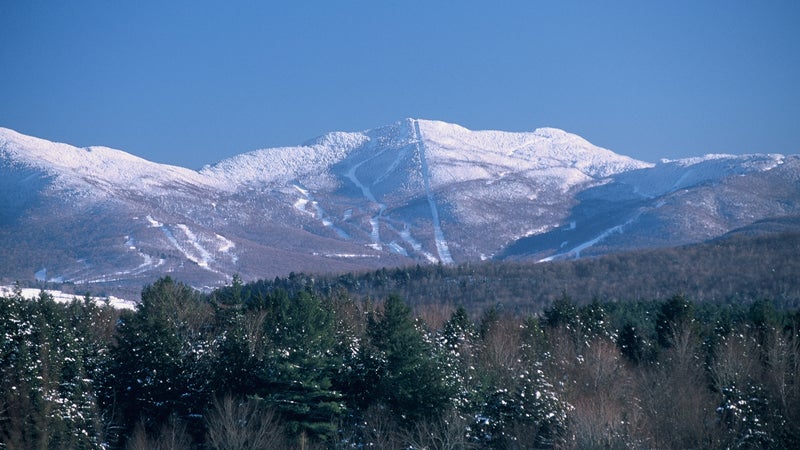
Smugglers’ Notch Resort (full-day tickets from $39) is a classic northern Vermont ski area that has managed not to fall into the cookie-cutter resort trap. Locals love it for the excellent terrain and low-key vibe. It’s reminiscent of the old Vermonters who have lived in the towns nearby for generations: sure, the resort could place high-speed quads here, but the skiing quality would go downhill fast.
The ski area has a modest base village with lodging and prides itself on its family programs. Drop the kids off for ski school, shred some classic runs, meet up for family time in the gentler terrain, and you have the makings of solid day. The area breeds strong skiers, of which I count my wife. When we first met, she told me she’d grown up skiing Smuggs, and I thought to myself, OK, this is going to work!
Need to Know
Bundle up for the lift ride. The Madonna I chair is a slow burn to the summit of Madonna Peak, at 3,640 feet. It also faces due north. These are all good things for snow preservation and ski quality, but bring an extra layer for cold days and late afternoons in December and January.
Plan according to skill levels. The area is divided into a lower area, Morse Mountain, and an upper area, consisting of Madonna and Sterling Mountains. Morse is perfect for families and those learning to ski. Sterling is also great for families who can split up on the downhill and reconvene at the chair.
Prepare for tree skiing. It’s abundant here, both within the ski-area boundary and outside of it. Make sure you’re prepared and know where you’re going if you venture off-piste. Some runs lead to the closed Route 108, from which you’ll need to hike and traverse back to the ski area.
Expect the resort to call it early. Things shut down early at the resort in terms of amenities, but there are plenty of places to grab après drinks and food as you head closer to the town of Jeffersonville.
When to Go
December through April typically yields quality skiing. School and holiday breaks get busy with local crowds. Non-holiday-weekend ski traffic is light, and midweek it’s a ghost town.
How to Get There
There are several ways to get to Smuggs traveling east from Burlington, all of which average an hour of driving. Route 108, which passes through the Notch from Stowe, is closed during the winter, so don’t go that way, no matter what Google Maps says.
The Intel
Where to Stay
The resort offers studio to four-bedroom condominiums (from $90) that are either a short walk or a free shuttle ride into the village.
Terrain
Steep bumps with natural features on Freefall, Liftline, and Robin’s Run will keep intermediate and advanced skiers entertained, in addition to excellent tree skiing, in-bounds and out. Last year Smuggs recorded 329 inches of snow. In-bound glades, such as Doc Dempsey’s, are classic Smuggs terrain, but backcountry stashes are abundant as well. Be prepared with your gear, partner, and navigation to get you to and from the ski area.
Off Hill
The Ben and Jerry’s scoop shop and Black Bear Tavern are a hit with families for après. There are also loads of kids’ activities in the Fun Zone, a 26,000-square-foot indoor playground at the resort. Off the hill, head down the road to Brewster River Pub and Brewery. In Jeffersonville, 158 Main Restaurant and Bakery is a delicious spot for breakfast, lunch, or dinner. If you’re looking to nab tasty baked goods on the go, hit up the Cupboard Deli for locally made goodies. It’s in a former gas station, so you may be tempted to judge, but its cookies and famous bear claw are worthy.
The Bottom Line
This is a local’s mountain, with a casual, throwback feel. While there are plenty of tough backcountry runs, Smuggs is also popular with beginners and families, thanks to gentler terrain options, like Sir Henry’s Learning and Fun Park and the Magic Carpet.
Sugarloaf Mountain, Maine
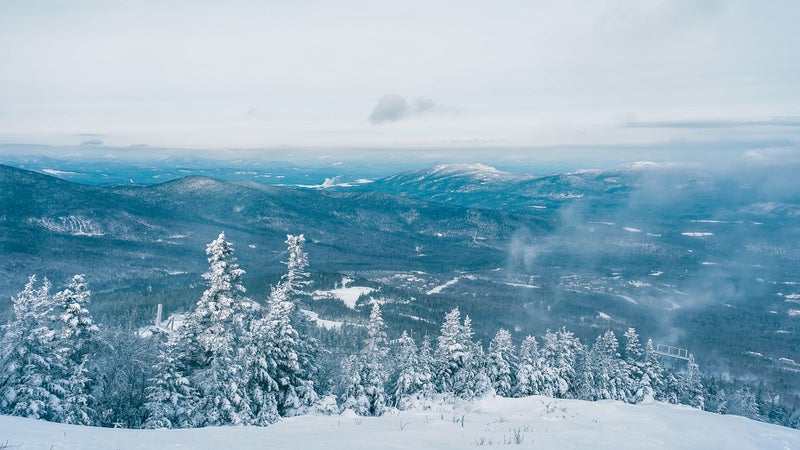
Rising out of the Carrabassett Valley in northern Maine, Sugarloaf Mountain (part of the Ikon Pass; full-day tickets from $109) appears akin to a volcano in the Pacific Northwest. The resort boasts one of largest continuous verticals in the east—2,820 feet—and its location well north of Portland, Maine, means fewer crowds than many of the more southern New England ski areas.
Other than Stowe, Sugarloaf is the only ski area in the East to offer alpine terrain. At 4,237 feet, Sugarloaf is the second-tallest mountain in the state, and long, sustained fall-line trails tumble downslope from the summit into steep bump runs or open fields of corduroy, begging you to let your skis run. The Loaf (as locals call it) also has some of the best trails for arcing fast groomers. And while this East Coast resort doesn’t have traditional tight New England trails contouring the mountain, it makes up for it with a plethora of newly opened gladed terrain. If you can stomach the heartier cold spells, there’s no better place to ski in Maine. The mountain has a vibrant, local vibe and is family friendly.
Need to Know
Look out for new sidecountry runs. Prior to opening up maintained backcountry runs like Brackett Basin, Sugarloaf was known for its snowfields and terrain park. There’s plenty of covert tree skiing still available off the Spillway chair: slide out of bounds, down the shoulder and back side of the snowfields, to a zone of trees that opens up with a couple lanes that stop at a small cabin called the Salsa Shack. Then continue down to a traverse and back to the King Pine chair, where some of the best natural snow skiing is. More recently, the Loaf boosted its skiable acres through glades and just added a new area off Burnt Mountain. Burnt was previously only accessed by hiking but can now be reached via a snowcat with the purchase of an access ticket (from $45).
Bring that extra layer. Cold temperatures preserve the mountain from the proverbial January thaws that can wreak havoc on other East Coast ski resorts. Having spent two years in this area, I’ve experienced overhead powder days and bone-rattling cold groomer runs with howling winds. Be prepared for New England weather that can change at any moment.
Mark your calendar. Reggae Fest is the biggest ski-area spring party I’ve ever seen. It happens every April at Sugarloaf and is full of good times.
When to Go
The Loaf can have reliable coverage from snowmaking in November. Once winter kicks in, the snow is usually good through April. Late winter and early spring are typically the best times to go, and the Loaf averages 200 inches of snow per year. Keep tabs on nor’easters, when storms unload on the resort as they travel up and stall within the Gulf of Maine.
Getting There
While “you can’t get there from here” is a classic Mainer response when you ask for complicated directions, luckily for skiers, Sugarloaf is easy to get to if you don’t mind a little driving. The closest large airport is either in Portland, Maine, or Boston, a 2.5- and four-hour drive, respectively. From Boston, take I-95/Maine Turnpike to Auburn, Maine, then Route 4 to Farmington, and then Route 27 north to Carrabassett Valley and the resort. If you’re traveling during the day, you’ll know you’re close when you hit Oh My Gosh Corner—when Sugarloaf’s broad face comes into view. The best part about Sugarloaf is its remoteness, and you’ll be glad you made the trek, given the diminished crowds.
The Intel
Where to Stay
Sugarloaf Mountain Hotel (from $99), just 100 yards from the SuperQuad lift, has an outdoor hot tub and an on-site restaurant called 45 North. There are also condos and vacation rentals that vary in price.
Terrain
For a ski area this big, it still feels manageable, given the simple base area. The breakdown of trails is 23 percent beginner, 34 percent intermediate, 27 percent advanced, and 18 percent expert. Additionally, the resort’s Brackett Basin and Burnt Mountain provide over 650 acres of backcountry-style glades. The snowfields atop Sugarloaf’s summit offer the only above-treeline, lift-accessed terrain in the Northeast.
Off Hill
Aside from the on-mountain restaurant Bullwinkle’s Bistro, all the other restaurants and bars are located at the main base area. Check out D’Ellies for lunch and the Bag and Kettle and the Shipyard Brewhaus for après brews. Alice and Lulu’s provides a finer farm-to-table dining experience.
The Bottom Line
Sugarloaf is great for families as well as skiers looking to get into the woods and newly opened terrain. It’s also the training grounds for the Carrabassett Valley Academy, a well-known ski school with racing and freeride programs.
The Backcountry at Mount Washington, New Hampshire
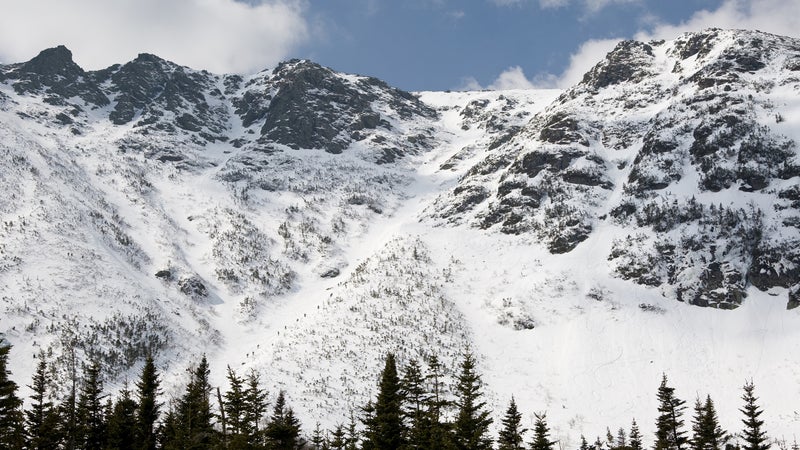
Mount Washington lies within the Presidential Range, located in White Mountain National Forest in northern New Hampshire. At 6,288 feet, it dwarfs the neighboring Green Mountains of Vermont. Its extreme weather has been documented from summit observatories for years, recording a long-standing record of the highest wind speed on land—231 miles per hour in April 1934. The mountain features 2,000 feet of terrain above tree line and 13 glacial cirques (bowls loaded with snow that span the ridgelines) and lies within the convergence of three separate storm tracks. It’s infamously known as home to the worst weather in the world. The terrain is also avalanche prone.
But when the weather is calm and the howling winds transition to nothing more than a breath, the steep chutes and bowls become a proving ground for backcountry skiers in New England and lure westerners, drawn to the region’s prominence in the history of North American skiing. That’s because the mountain is home to a famed cirque called Tuckerman Ravine, a rite of passage for many East Coast skiers. Located on the southeast face of Mount Washington, the ravine requires boot-packing up a 50-degree pitch before thundering down a chute that’s close to vertical.
Need to Know
Get the gear and the training. Bring avalanche gear, and know how to use it. There are several outfits within Vermont and New Hampshire that offer Level 1 Avalanche classes. In addition to taking the class, practice using your gear—especially when you’re tired and cold, because that’s typically when accidents happen. In addition to a beacon, shovel, and probe, Mount Washington skiers should be comfortable using crampons and ice axes. Before you go, check the Mount Washington Avalanche Center, which provides forecasts along with weather and photo updates.
Familiarize yourself with safe zones. The lower parts of the Sherburne Ski Trail and Gulf of Slides Ski Trail, which start off Pinkham Notch, bob and weave down the mountain. They function as a safe space for touring if the avalanche hazard is high, because the trails are sheltered by heavy tree coverage. Be savvy and don’t push it when conditions are sketchy, as slides historically have sent timber flying onto these trails.
Make sure to have a map and compass, or use Gaia GPS. On the west side of Mount Washington, there are alpine cirques similar to Tuckerman Ravine, such as Ammonoosuc Ravine and Monroe Brook. Make sure to have navigational tools handy in case you lose your way in these high mountains.
When to Go
Luckily, those howling winds on Mount Washington deposit loads of snow during storms. Weather and snow conditions vary greatly day to day. Typically January or February through May is a safe bet for good snowpack.
Getting There
Pinkham Notch is the most popular trailhead start location. It’s on Route 16 in northern New Hampshire and is a mile south on White Mountain Road from Wildcat Ski Area, another well-known destination known for its variety of terrain. Pinkham Notch is a three-hour drive from Boston and a two-hour drive from Portland, Maine. From the Notch, you can access the Sherburne Ski Trail, Tuckerman Ravine, Huntington Ravine Trail, and Hillman Highway’s Ascent. Additionally, the Gulf of Slides Ski Trail begins here and leads to the Gulf of Slides and Oakes Gulf ravines.
The Intel
Where to Stay
Joe Dodge Lodge (from $70), located at Pinkham Notch, has private rooms and bunk rooms with shared baths, plus a breakfast buffet. If the weather allows, Hermit Lake Shelter (from $15), located 2.4 miles up Tuckerman Ravine Trail, is the only area permitted for camping on the east side of Mount Washington. The lean-tos and tent platforms are available on a first-come, first-served basis, and a permit can be obtained at Pinkham Notch.
Terrain
The most popular area on Mount Washington is Tuckerman Ravine. Since the early days of the Inferno Race, when shredders barreled down the Lip and Sherburne Ski Trail during the 1930s, Tuckerman Ravine has been a test for skiers. I distinctly remember skiing over its Center Headwall for the first time: the slope peeled away with each turn, creating an exhilarating drive to see more of it. The first time I scored one of its chutes in the early spring, a long, white canvas in front of me, it was even more special.
Off Hill
Don’t miss après beers and BBQ at Moat Mountain Smokehouse and Brewing Co. and the Red Parka Steakhouse and Pub, especially after a day of backcountry touring.
The Bottom Line
Skiing on “the Big Rock,” as locals call the mountain, shouldn’t be taken lightly. From 50-degree steeps, ice-bulge cliffs bisecting chutes, avalanche danger, and late-season crevasses, it’s as real as it gets on the East Coast and a skiing mecca for those with the skills to experience classic backcountry terrain.

